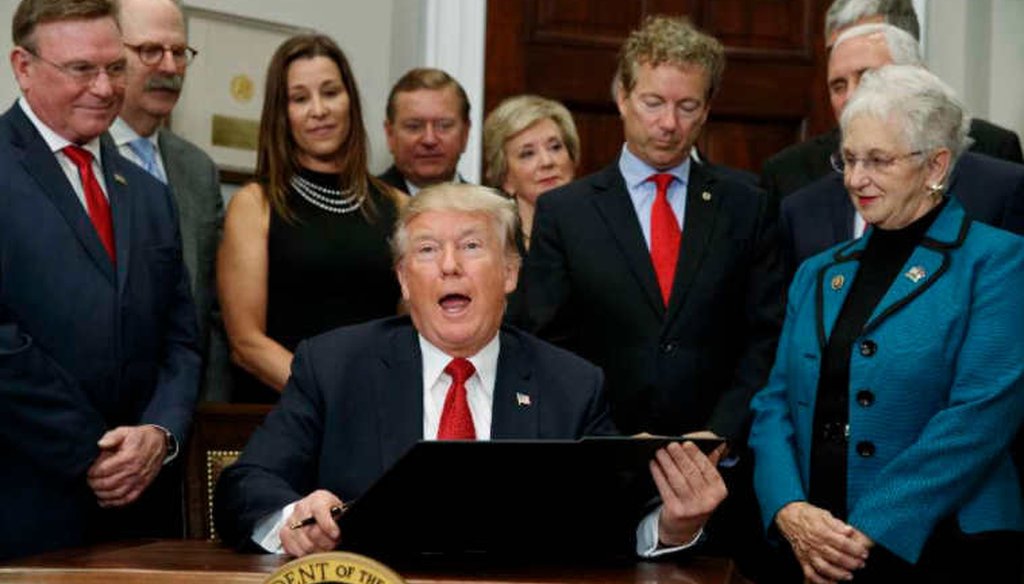Get PolitiFact in your inbox.
Rule-making might change the playing field

President Donald Trump signs executive order to expand association health plans. (AP)
Update: The administration released its proposal Jan. 5, 2018, to loosen the rules on association health plans. The measure retains protections on pre-existing conditions but would allow plans to cherry-pick the benefits they offer explicitly to reduce insurance premiums. The classic example would be to exclude maternity care because not everyone needs it.
The proposal offers a limited ability to sell insurance across state lines. That would be allowed in metropolitan areas, for example New York City or Kansas City where economic zones cross state borders. A final rule is many months away.
President Donald Trump signed an executive order that could open the door to making good on his promise to sell insurance across state lines. Whether it happens depends on the rules that finally emerge, and that's going to take some time.
There is no question as to Trump's intent. In October, he told various Cabinet departments "to facilitate the purchase of insurance across state lines" by drafting regulations on three fronts:
-
Expand access to association health plans
-
Expand access to short-term insurance
-
Expand access to health reimbursement accounts
The first two have the greatest potential to fundamentally change the kind of coverage that people can buy. Association plans are insurance set up by professions or clusters of small employers. You might see groups organized by home remodelers, accounting firms or some other line of work.
Under current law, these associations are treated as small employers and subject to key rules of the Affordable Care Act. For example, their plans must offer 10 essential benefits, like emergency room treatment and maternity care, and they can't discriminate based on a person's health.
The main effect of the executive order would be to lift those requirements.
Short-term plans offer limited benefits for up to three months. They're basically for people caught between jobs in need of catastrophic coverage until they land a new position. These plans operate under none of the Obamacare rules.
New regulations could allow these plans to last for many more months.
The administration doesn't enjoy complete freedom here. It must work within the Employee Retirement Income Security Act of 1974, the law that sets minimum standards for private health plans. But in theory, the administration could craft language that allows association plans to follow the insurance rules in a state of their choosing, rather than the state where the person buying the plan lives.
Supporters see movement on both fronts as the path to cheaper insurance for millions of people. And that would likely happen in the short term. But a host of concerns surround such changes.
The ripple effects
Association and short-term plans would attract customers because they could offer skinnier coverage at a cheaper price. For people who think they are healthy, and likely to stay so, that would be an acceptable trade-off.
State insurance regulators fret over the implications. In Senate testimony, the National Association of Insurance Commissioners warned that association plans would "cherry-pick the healthy."
"This, in turn, would make existing state risk pools even riskier and more expensive for insurance carriers, thus making it even harder for sick groups to afford insurance," Raymond Farmer, the commissioner from South Carolina, said in September.
Many groups that focus on the stability of insurance markets caution that Trump's initiative would create two insurance universes. The one with association and short-term plans would have younger, healthier subscribers. The other would have older and sicker people. The costs in one would be low. The costs in the other would be high.
The Kaiser Family Foundation, a neutral source of health policy data, looked at a Senate proposal for association plans and predicted "significant premium increases and instability" in the small-group and non-group markets. The Kaiser analysis said that dynamic would be even more powerful if groups and individuals were able to use the cheaper plans when they were healthy, but then switch to traditional insurance when they got sick.
That might force insurers to get out of the market "because they could not predict the risk of potential enrollees."
As of publishing, we are still waiting on the administration's proposal. Even after that arrives, it will be at least several months before the public has a final rule.
But the wheels are turning, so we rate this promise In the Works.
Our Sources
White House, Presidential Executive Order Promoting Healthcare Choice and Competition Across the United States, Oct. 12, 2017
Senate Health, Education, Labor and Pensions Committee, Testimony of Raymond G. Farmer On Behalf of The National Association of Insurance Commissioners, Sept. 14, 2017
Kaiser Family Foundation, Association Health Plans for Small Groups and Self-Employed Individuals under the Better Care Reconciliation Act, June 2017
America's Health Insurance Plans, Association Health Plans Issue Brief, Oct. 6, 2017
National Association of Insurance Commissioners, Association health plans are bad for consumers, accessed Jan. 2, 2018
Vox, Association health plans: Trump's attack on Obamacare, explained, Dec. 29, 2017
